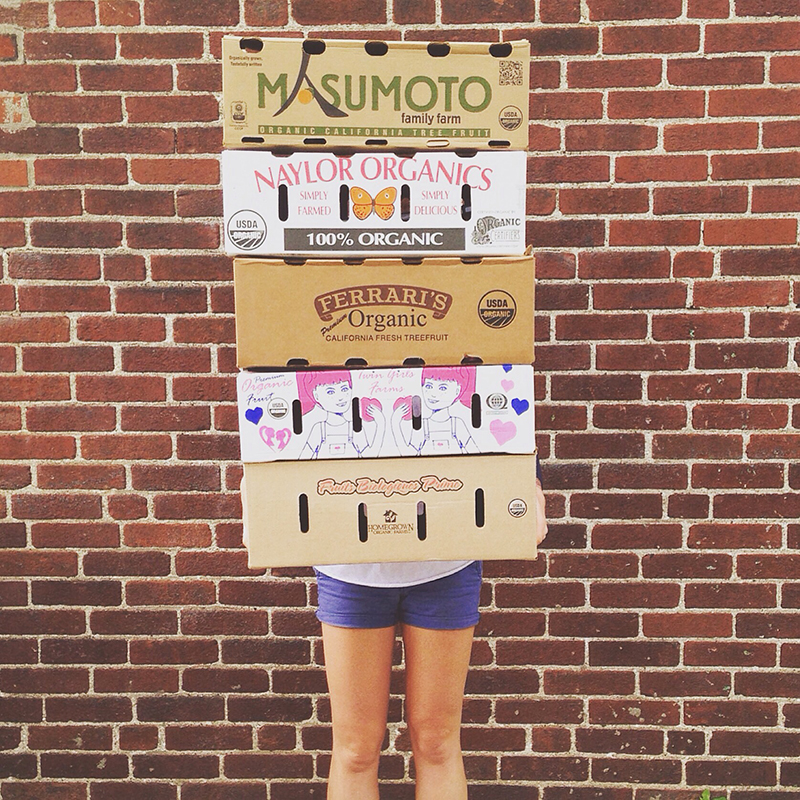
June Crest yellow peaches harvested by Masumoto Family Farms in Del Rey, California.
The heart of June often evokes a childhood nostalgia for summer vacation, as evidenced by a recent discussion in the office here at Formaggio Kitchen. Among trips to the beach, overnight camp and baseball games, many staff members agreed upon the taste of ripe peaches and nectarines when asked what truly evoked childhood summer memories. Somewhere in the midst of the office chatter, a little known fact was brought to light: peaches and nectarines are not separate varieties of stone fruit, but actually biologically identical with only contrasting skin textures (peaches are fuzzy, nectarines are smooth). Understandably, this piece of information perplexed quite a few people in the room, but before any scientific explanation was offered, the lunch rush began at the shop and it was time to get back to work. As the produce manager at Formaggio Kitchen and among those recently enlightened, I vowed to further research the subject and share my findings.

Much like their incredible aroma and flavor, the biology and genetic makeup of nectarines and peaches is rather complex. Also known as stone fruit, nectarines and peaches fall into the genus Prunus, alongside almonds, apricots, cherries and plums. Species of this genus are woody, with perfect spring flowers with an ovary that matures into the fruit, or drupe. Each drupe is divided into two parts: the mesocarp (outer skin and flesh) and the endocarp (inner pit).
Now that it’s clear that peaches and nectarines are scientifically the same fruit (Prunus persica), what gives the peach its distinct fuzzy skin?
High school biology class teaches that genes are the unit of heredity transferred from parent to offspring. Alleles are the possibilities of said gene, resulting in varying physical attributes. In nectarines and peaches, fuzzy skin is the dominant allele. Nectarine trees occur when both parents pass the recessive allele for smooth skin to its offspring. This Punnett square illustrates a sample genetic cross, with the capital F representing the dominant allele for fuzz, and lowercase f representing the recessive allele for smooth:

Peach punnett square showing recessive alleles for nectarine propagation.
In addition to this variant, peaches and nectarines may either be white or yellow fleshed, freestone or clingstone. Yellow fleshed fruit tends to be higher in acid than its counterpart, with a bracingly tart yet pleasant flavor that excels in baked goods. In contrast, fruit with a white flesh are lower in acid with a sweet, floral flavor, perfect for eating out of hand. As one may deduce from the name, freestone fruit has a pit that will fall easily away from the flesh when halved, whereas clingstone has a pit that will messily cling to the fruit.
There is absolutely nothing sweeter than selecting a locally grown peach, but while we wait for the delayed New England harvest, we work closely with SF-based produce distributor Veritable Vegetable. A certified B corporation, Veritable Vegetable places high value in strengthening communities and sustainable practices by supporting small, organic farms that specialize in heirloom varieties of fruit and vegetables. Through Veritable Vegetable we have been granted access to some of the best fruit grown in the United States, including fruit grown by David Mas Masumoto in Del Rey, California. Recent author of LA Times pieces reflecting upon the severe drought in California, David Masumoto is not only a source of farming knowledge and technique, but also an advocate of sustainable growth and resource management. At Formaggio Kitchen, our produce department sources extremely high quality stone fruit from both local and California farms that have been left to mature on the branch for as long as possible, encouraging proper ripening and greater depth of flavor. By choosing excellent growers, we find that we have some of the best tasting and most interesting varieties available on the East Coast.
Our cheesemongers suggest pairing stone fruit with various styles of cheese, but we enjoy pairing juicy summer stone fruit with Robiola Roccaverano DOP, a creamy goat milk robiola from Piedmont, Italy or alongside a few slices of La Quercia speck from Norwalk, Iowa.
Author - Emily Shannon is the Produce Manager at Formaggio Kitchen Cambridge.

